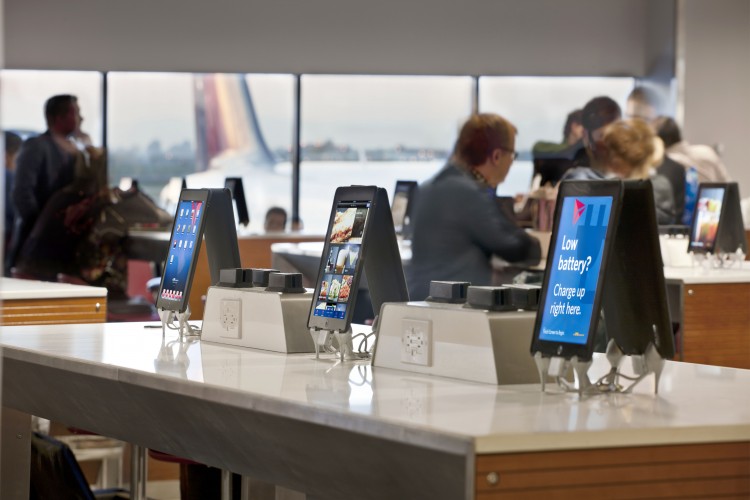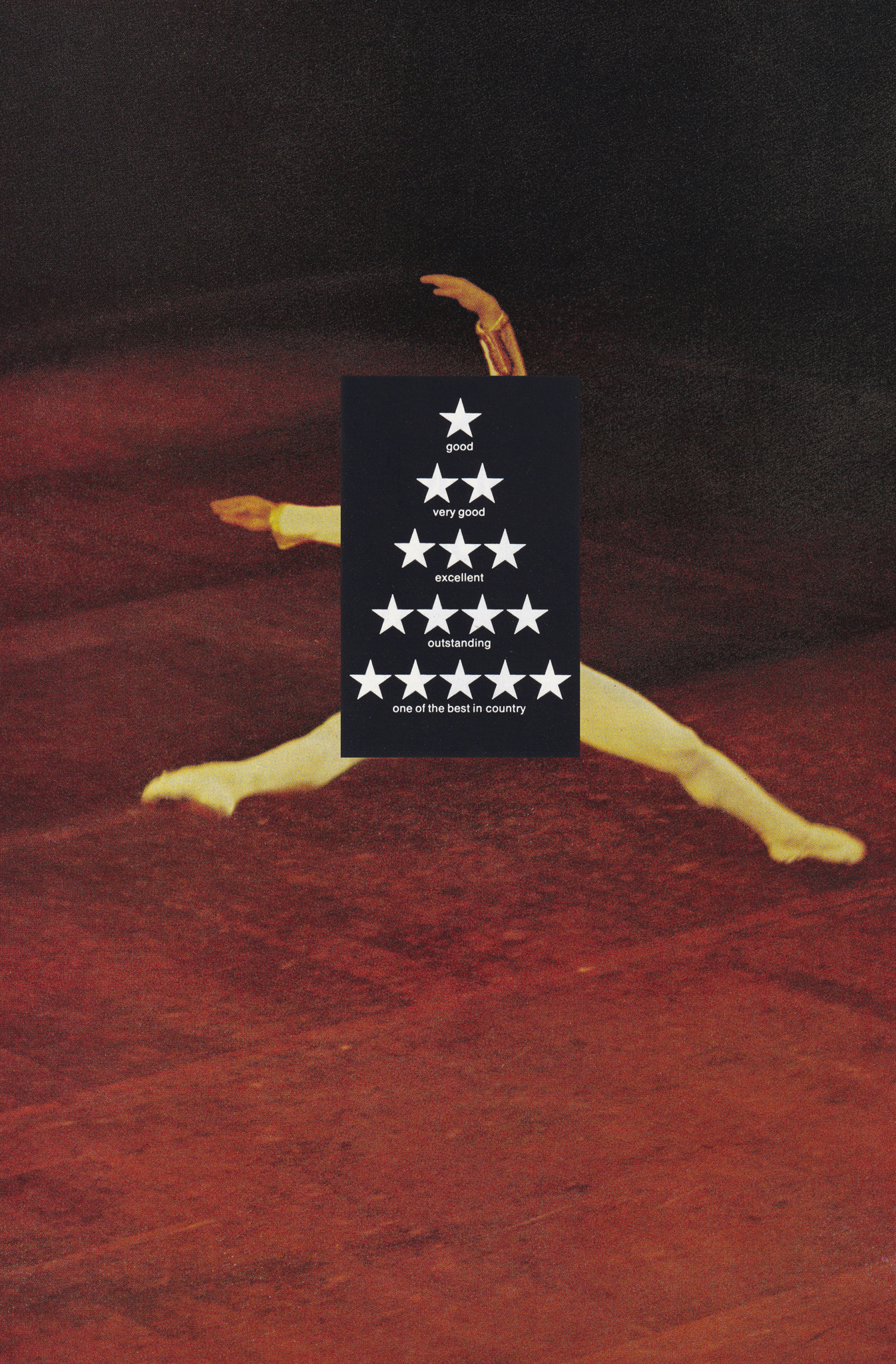Recently, in the relative lull between vaccination and variants, I had the chance to do some traveling. Like many, I was surprised by the hodgepodge of new rules, infrastructure, and technology that had been deployed in the airport to promote safety: Questionnaires, temperature checks, ostentatious wipe-downs — the usual cast of hygiene theater. Yet, as I strolled the freshly renovated terminals, I was struck by what had not changed: dozens and dozens of those iPads that have “invaded” airports over the past decade. Propped in the middle of restaurant tables, terminal bars, and gateside waiting areas, the sleek, flashing tablets offered patrons the chance to order food and drink, or play an ersatz version of slots, beckoning users to “Play. Drink. Eat.” More often than not, their screens were filled with fluorescent ads.
As I waited for my flight, I briefly contemplated ordering from the McDonald’s touchscreen, but then recoiled at the remembrance of germs: At a time when we are constantly reminded to wash hands and minimize touch, airport iPads stand out as smudgy vectors. Despite the inviting slogans, I did not spot a single person using them; the more I thought about it, though, I couldn’t recall having ever seen many people interacting with the tablets. Nor could I remember using one myself — except to push them away, commandeering table space for my own devices. If I had any desire to play a knock-off version of Tetris in the waning minutes before boarding the sweaty antechamber of the flight deck, why wouldn’t I play on my own phone?
iPads in public spaces, despite their theoretical functionality for consumers, are primarily aesthetic
A series of images from the LaGuardia, Toronto, and Minneapolis airports depict scores of iPads hauntingly untouched, fixtures to be maneuvered around and ignored. Looking around the bustling terminal at the abandoned screens, I wondered why the designers of lounges and restaurants would insist on such an expensive upgrade. If most people have no occasion to use them, why do these devices even exist here?
OTG, a company that promises to “reinvent the airport experience to make you travel better and happier,” has been involved with many of the largest airport renovations in modern history, including those at JFK, Houston, Philadelphia, and perhaps most lavishly, Newark’s $120 million Terminal C. Apple-branded iPads, along with celebrity chefs and locally sourced cuisine, are one of the core planks of OTG’s program of modernization. The company’s website boasts about the thousands of iPads “deployed” at each airport: over 1,000 in Philadelphia; 2,500 in Toronto; more than 5,500 in Newark.
The stated goal of this technology is to improve hospitality: to reduce errors in ordering, to ameliorate boredom. The New York Times highlights the ability to browse the web and check a flight’s status from the newfangled tablets, while OTG entices retailers with the possibility of increased sales, algorithms supposedly boosting patrons’ food and drink orders. Specifically, the company claims that its iPads have helped reduce voided transactions (those cancelled due to being incomplete or erroneous) to 0.5 percent, while increasing revenue by 30 percent.

Similar screens abound: in the back of yellow cabs, spouting a relentless stream of highlights from The View; at the gas pump, airing 15-second snippets of Friends; at Taco Bell; at the dentist’s office; at the bank; on the sidewalks of major city streets; in hip clothing stores. Travelers at Singapore International Airport are asked to rate their bathroom experience on a touchscreen, either a lurid testament to, or a massive indictment of, the city-state’s famed cleanliness. People are rarely asked to rate the usefulness of touchscreens themselves. Frequently, use is compulsory, like at certain cafes or restaurants. A friend of mine attends a college where every student is required to purchase an iPad before matriculation, even if they already own one. Perhaps not coincidentally, her university has been named an Apple Distinguished School, an accolade bestowed upon institutions ranging from Christian prep schools to Caribbean veterinary programs that abide by a one-to-one device-to-student ratio.
It may be that these gadgets are not primarily for consumer use, but for use by management. As the CEO of Gas Station TV blithely put it, “Our consumer is tied to that screen with an eight-foot rubber hose for about five minutes fueling… there’s really no super magic. When people pump gas they have nothing to do.” With over 70 million unique viewers each month, Gas Station TV commands a massive — if unwilling — audience and promises unprecedented opportunities to sell ads; each gas station has a unique IP address, allowing for local and targeted campaigns. Managers see an obvious opportunity in this tailored marketing as well as in the promise of accruing consumer data (“the new oil”). Back in the airport, OTG claims that travelers shell out 43 percent more in terminals with touchscreens, which enable managers to collect data not only on customers, but also employees: Companies like OTG promise to help identify the highest “performers” among restaurant and bar staff, and push the less profitable to increase sales.
The panoply of iPads, at airports and elsewhere, also provides something symbolic that has less to do with interaction than appearance. One need only look at OTG advertisements to understand that iPads in public spaces, despite their theoretical functionality for consumers, are primarily aesthetic — a feature alongside high-arched ceilings, evanescent seating, and minimalist art.
iPads and other “smart tech,” even if they remain untouched, signify quality. This is true of restaurants, hotels, and gas stations, and even more of airports like JFK, where people are landing from anywhere in the world, from any socioeconomic background. iPads are the metonym for luxury — their very superfluousness speaks volumes about the venues in which they’re placed. Like fancy watches that can withstand pelagic depths, or sports cars that can reach 200 mph, airport touchscreens don’t need to be used to their maximum capacity — in fact, they don’t need to be used at all, at least by patrons — to confer value to their environment.

iPads afford a sense of high quality, but also of progress and modernization, even if the fundamental attributes of a good or service have not changed. In this regard, iPads are transformed from pieces of technology into icons. As theologian Harvey Cox explained, “Technological artifacts become symbols when they are ‘iconized,’ when they release emotions incommensurate with their mere utility, when they arouse hopes and fears only indirectly related to their use, when they begin to provide elements for the mapping of cognitive experience.” The iconization of iPads is so profound that they are interwoven into the mythology and cognitive experience of progress itself. When a place is modernized, iPads follow. Consider, for example, the iPad kiosk launched at Chesapeake Bank, which proclaimed, “My, my, my, how banking has changed!”
I’m reminded of my middle school in Florida, which, like many across the country, unveiled “smart boards” in the early aughts. These devices, I’m sure, had dozens of nifty functions, but largely wound up as ultra-expensive chalkboards; more importantly, they did nothing for our curriculum, which stayed grounded in the preceding century. Similarly, the airport iPad may save the traveler a few minutes ordering a Bloody Mary, but it doesn’t affect the most crucial aspects of air travel: promptness of flights, baggage delays, pilot acumen, engine functioning, air traffic controller fatigue. The most important technological features of air travel — weather prediction systems, cabin pressurization and filtration, radar — are often the least visible to the consumers that benefit from them the most.
I’m in medical school, and as I began to reflect on technological performativity, I was surprised to notice it all around me, in the classroom as well as the clinic. Despite the genuine advances of the last several years — monoclonal antibodies, gene editing, an mRNA vaccine — my attention was often drawn to the icons I had come to expect of a technologically sophisticated place: iPads in every surgical skills laboratory and waiting area, dignified check-ins and check-outs. Many exam rooms now have two computer monitors. These things are expensive, and I have never needed to use more than one at a time. For years, in fact, doctors have decried how their computer screen disrupts the attention they are capable of affording patients. Now they are stuck with two.
In “A signalling theory of excessive technological adoption,” authors Pedro Pita Barros, Carlos Gouveia Pinto, and Ana Machado contend that expensive gadgetry is often purchased to signal some “unobservable quality,” in this case, medical knowledge. Given the significant information asymmetry in healthcare, the authors predict a kind of prisoners’ dilemma for physicians who, in aiming to establish their quality, precipitate a medical arms’s race.
Like sports cars that can reach 200 mph, airport touchscreens don’t need to be used to their maximum capacity to confer value
We crave tangible assurances of value. Patients never actually see the drug-eluting stent that goes in their heart, nor the minute chemical reactions that lower their cholesterol. But what they do see are the trappings of an advanced clinic: tech-savvy staff, zippy elevators, doctors punching away at lightning-fast desktops, students assiduously taking notes on sleek tablets. And since actual patient outcomes only comprise 37.5 percent of a hospital’s ranking — with much of the rest based on subjective measures like patient experience, specialty-specific recognition, and expert opinion — it is to these highly visible symbols that an average person must turn to determine quality. Ultimately, hospital administrators may deem a bevy of sleek iPads a worthy investment if only for the appearance of tech sophistication they exude to physicians, patients, and for the rankings.
I found myself succumbing to this heuristic when I went to my own doctor’s appointment. As I completed my intake paperwork with a Bic pen tied by shoelace to a plastic clipboard, I found myself doubting whether I had gone to the best specialist — even though she had come highly recommended, was an expert in her field, was patient and compassionate. Did it matter how digitized my waiting room experience was?
Some might counter that a willingness to embrace technology correlates with a physician’s general interest in modernization, and thus doctors who use iPads and flat screens are more likely to give up-to-date care. I’m not convinced, though, as physicians are increasingly not owners of their practices but rather employees, and as decisions about rooms and decor are made on high by corporate purchasing departments, who are often concerned most with boosting patient volume. Such symbolism may work. A study published this summer in JAMA confirmed that physicians who wear white coats are perceived as more experienced, professional, and friendly than those wearing jackets.
Over a century ago, Henry Adams, an American historian who visited the 1900 Exposition Universelle, a kind of World’s Fair, drew religious allegory from the massive dynamos found in the Palace of Electricity. Seventy years later, as LM Sacasas recounts, Harvey Cox wondered how Adams would conceive of the automobile, atomic bomb, or commercial jet. Today, a modern exhibition of technological marvels would be largely imperceptible; none of us can see 5G broadband, or CRISPR, or even the great inventions of the internet or social media, at least not in the way Adams saw the might of the dynamo. There has been plenty of important technology advanced in airports and cities that people actually use, like high-speed wifi and municipal broadband. However, such innovations, despite their utility, are basically invisible.
The enduring presence of touchscreens in modern life is explained by their status as highly observable stand-ins for progress. Designers of spaces seeking to mark sophistication feel compelled to create some monument to technology — iPad stations, or interactive urban kiosks. These screens are vessels that manifest our connectivity to the immense technological competence of the era, and provide a sense of physicality — something to touch.
Much has been made of touch, or our relative lack of it, during a pandemic in which the sense has been maligned and forbidden. It’s a cliche that touch — a hug, an embrace — has the power to heal. But what has been called the deepest sense is also perhaps the most intertwined with power. To touch is to conquer, to command. As the American Ethnological Society summarized it, “Touch, as experience, sense, and activity, is both a point of contact with the world and a worlding in itself, central to our capacities to affect and be affected… The veritable frontline for both harming and flourishing, touch is essential to companionship, cultivation, sexuality, as well as manifold forms of violence, contagion, and a variety of other multivalent fleshy exchanges.”
These screens are vessels that manifest our connectivity to the immense technological competence of the era
It is notable that the most widespread artifact of technological progress, entertainment, and interactivity — found everywhere from fast food chains to elite office spaces — is the touchscreen. Touching screens, we touch the world. Sometimes this sensation is illusory. Like “placebo buttons,” which purport to close the elevator or change the crosswalk light, iPads in airports can give users a haptic illusion of control, a sense of tactile agency in an otherwise chaotic and overwhelming environment. To touch is seemingly to affect real change. With the fleshy end of the finger we say, “Yes, I want this drink.” Run the same finger along a screen and sign a name. Authorize a credit card or consent for surgery. The exhilaration and fatigue of the swipe right, swipe left. There’s a reason Apple’s great inventions were the double tap, pinch and zoom, drag and drop. These moves allow the user to manipulate — literally shape with the hands — information.
And yet, to paraphrase Merleau-Ponty, to touch is always, in some sense, to be touched back. The screens that surround us beg to be touched, and to touch us. Designers of spaces hope to reach out to consumers when they integrate iPads; consecrating a place as sophisticated and processing those who pass through, surveilling and extracting our data.
As I line up for my flight, I scan my QR code, hear the beep. I look back at the iPads, which stare back at me. It’s a sign of security, a show of force, too. So much expensive decor, and none of it absconded. Overabundant and underused, these iPads appear less like luxury tokens and, instead, like clutter — tawdry, obtrusive, unavoidable. As Barros, Pinto, and Machado note, “if all hospitals do it” — purchase expensive equipment to signal quality — “no information is revealed.” In other words, once every office has iPads, no longer are any of them fancy. At which point the way to signal quality is to offer a reprieve from the flashing ads and cheap games. iPads appeared in luxury lounges before they were unrolled for the general public. Today, I suspect those same lounges look comparatively austere.
A young man rolls his bag to the marble countertop where I had been standing, his wireless headphones lodged in deep. Slipping off his backpack, he removes a laptop, opening Netflix. I can’t tell if he notices the iPads in front of him, based on how swiftly he removed his own device and dove into his entertainment. Not that it matters, exactly. The iPads, touched or untouched, radiate their persuasive power. We may not be using them, but they’re serving their purpose.
